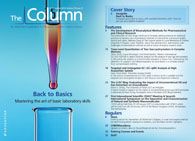The Development of Bioanalytical Methods for Pharmaceutical and Clinical Research
The production of new drugs continues to increase, placing pressure on analytical scientists to develop new bioanalytical methods to characterize and ensure quality control and safety. Bethany Degg of The Column spoke to Lucie Novakova of Charles University in Prague, Czech Republic, about the development, optimization, and challenges of bioanalytical methods as well as future emerging research areas.
Photo Credit: RomanOkopny/Getty Images

The production of new drugs continues to increase, placing pressure on analytical scientists to develop new bioanalytical methods to characterize and ensure quality control and safety. Bethany Degg of The Column spoke to Lucie Nováková of Charles University in Prague, Czech Republic, about the development, optimization, and challenges of bioanalytical methods as well as future emerging research areas.
Q. Much of your work is focused on optimizing bioanalytical methods, what are the objectives of bioanalytical method development?
A: Bioanalysis is indispensable for elucidating various biological processes. Our work on bioanalytical method development allows our participation on various interdisciplinary projects, such as searching for potential new drug effects.
The aim of quantitative bioanalytical methods is to selectively, accurately, and precisely determine the amount of a target analyte (usually a drug, metabolite, or biomarker) in complex biological samples (fluids or tissues). The requirements for modern bioanalytical method development are now focused on the speed of analysis, efficiency, low cost, miniaturization, and automation to enable high sample throughput in the laboratory, as well as the basic requirements of sensitivity, accuracy, and precision. The latter requirements are ensured and properly verified during a thorough method validation that must meet rigorous criteria of various authorities, such as the EMA (European Medicines Agency), ICH (International Conference on Harmonization of Technical Requirements for Registration of Pharmaceuticals for Human Use), or the US Food and Drug Administration (FDA).
I think it is necessary to state that the development of bioanalytical methods has become more and more challenging over the past few years. The concentrations of the analytes to be monitored are often very low, while the number of samples to be analyzed is still increasing. This results in very demanding requirements in terms of method reliability - strictly controlled by the above-mentioned authorities - method sensitivity, speed of analysis, and sample throughput. Liquid chromatography–mass spectrometry (LC–MS) has therefore become a method of choice in this field.
Q. Some argue that the sensitivity of mass spectrometry has improved to the point that separation is not required prior to injection to an MS system. To what extent do you agree or disagree with this statement and why?
A: This might be true to a certain extent. In my opinion, such an approach is very useful in fast screening strategies, especially when very high throughput is required. However, to compensate for matrix effects, and also possible competition of individual analytes in electrospray ionization (ESI), the use of stable isotopically labelled (SIL) internal standards (ISs) is mandatory. Unfortunately, such standards are often very expensive, difficult to obtain, and most importantly do not eliminate matrix effects. They are only able to compensate for the error in quantitation by providing the same chromatographic, ionization, and fragmentation behaviour. This means that significant ion suppression may still cause a loss of sensitivity for some analytes despite using MS–MS detection, which typically provides high sensitivity and selectivity.
Moreover, there are other risks of direct analysis using MS without prior chromatographic separation. These risks are strongly matrix dependent. If the matrix is complex, it is important to exclude several sources of interferences, such as (1) isobaric compounds: These compounds cannot be resolved by MS, even when using high-resolution mass spectrometry (HRMS) because they have the same molecular weight and summary formula; (2) isotopic contribution: This typically occurs for chlorinated or brominated compounds with a strong M + 2 isotope contribution; (3) the presence of the adducts with the same mass-to-charge ratio (m/z); (4) the presence of the metabolites with the same m/z; and (5) interconversion reactions that are typical for several classes of compounds (such as lactone to hydroxy-acid or redox reactions).
Using LC easily separates most of these possible interferences. In my opinion, chromatographic separation is indispensable because the presence of all the interferences mentioned previously cannot always be excluded with a high level of reliability when the analytes are determined in complex matrices, such as biological materials.
Q. What are the ideal sample preparation and clean-up methods in bioanalysis in your opinion?
A: In my opinion this has not been invented yet. In an ideal world there would be no sample preparation. Why? The sample preparation step remains the most time-consuming part of an analytical method. It is often a multi-step procedure and a potential source of many errors. As well as the time factor, it also increases the cost of the analysis. Developments in ambient ionization techniques have already eliminated some sample preparation steps prior to MS analysis.
Many new ambient ionization techniques have been introduced, such as DESI (desorption electrospray), DART (direct analysis in real time), FIDI (field-induced droplet ionization), and many others. These enable fast and direct analysis at ambient conditions without any sample preparation and therefore allow very high sample throughput. However, they are not yet applicable for quantitative analysis and suffer from other drawbacks, such as a high incidence of matrix effects or a low sensitivity as a result of matrix interferences that are not removed either by separation or by sample preparation. Therefore, in most instances the direct analysis of complex matrices is impossible without appropriate sample preparation and clean up.
In my opinion, microextraction techniques based on solid-phase extraction (SPE) principles represented by microextraction by packed sorbent (MEPS) or disposable pipette tips extraction (DPX) are already pretty close to the expected ideal. They are both based on well-known conventional SPE protocols. Other advantages are very low requirement of both sample and solvent for analysis, fast sample preparation, and the option to tune the selectivity based on the choice of extraction phase. The automation of the extraction process is possible for both types of techniques. If the extraction is performed manually, there is a greater demand on the skill of the operator. To fine tune the selectivity further, utilization of molecularly imprinted polymers (MIPs) as an extracting phase is an interesting option, which should be examined in more detail in the future.
From my point of view, the technique of dried blood spot (DBS) analysis appears to be a very interesting, fast, and simple approach for sample pretreatment, especially in screening strategies. Easy sample collection, storage, and transport are other great advantages of this technique. Unfortunately, it is only applicable for blood analysis, which excludes determination of the analytes in other biological fluids or tissues.
Q. Which methods are required for quality control and characterization of biopharmaceuticals?
A: Biopharmaceuticals are drugs that are produced by biotechnology or by genetic engineering. They possess a macromolecular structure and often originate from heterogeneous mixtures made from the products of living organisms, cells, animals, or plants. There are now more than 130 different proteins or peptides that have been approved for clinical use by the FDA, and this number is expected to continue to increase quite rapidly. Structurally biopharmaceuticals may include monoclonal antibodies, blood or growth factors, thrombolytic agents, hormones, enzymes, interferons, interleukin-based products, and tumour necrosis factors.
For these biomolecules, slight changes in their structure might induce significant changes in their properties and ultimately their pharmacological effect. Therefore, their structure and any modifications have to be determined thoroughly. According to the ICH guideline Q6B, the characterization of biopharmaceuticals includes the determination of physicochemical properties, biological activity, immunochemical properties, purity, impurities, contaminants, and, finally, quantity.
As a result of their macromolecular structure, complexity, and diversity, the quality control (QC) of biopharmaceuticals is very challenging. Classical high performance liquid chromatography (HPLC) or ultrahigh-pressure liquid chromatography (UHPLC) techniques coupled to UV detection, commonly used in QC of pharmaceuticals based on small molecules, are not sufficient. A combination of multiple approaches including special advanced separation technologies is indispensable. Various analytical methods involving immunochemical assays, electrophoretic methods, high-resolution chromatographic (especially nano-LC), and mass spectrometry approaches are of great importance. HRMS with electrospray or matrix-assisted laser desorption (MALDI) ionization has become one of the most widespread techniques because of its sensitivity and flexibility. Time-of-flight (TOF)-based (TOF or QTOF) or Fourier-transform-based (FT-ICR [ion cyclotron resonance] or orbitrap) analyzers meet the demanding criteria for resolution and mass accuracy.
Both bottom-up and top-down proteomic approaches are used. The top-down approach enables the determination of intact molecular weight. A comparison of theoretical and experimental masses provides a direct indication for the homogenity and the molecular integrity of the biopharmaceutical. Using the bottom-up approach, the primary structure of proteins could be elucidated quite easily with the currently available LC–HRMS approaches typically combined with nano-LC separations. Determination of secondary, tertiary, and sometimes quaternary structure is much more difficult and still requires further investigation and development. Advanced techniques including nuclear magnetic resonance (NMR) and X-ray crystallography are often applied even though they are not ideally suited for this purpose. Protein labelling approaches or ion mobility spectrometry (IMS) might also be useful approaches in some instances. To sum up, QC of biopharmaceuticals is a very complex and challenging task.
Q. What new areas of research will emerge in the field of bioanalysis in the future?
A: I have mentioned the two main bottlenecks complicating development of bioanalytical methods; solving these problems requires further research and development. First of all, a very important bottleneck of bioanalytical LC–MS–MS methods is the presence of matrix effects. Several strategies, including enhancement of selectivity and clean-up during sample preparation or an increase in separation efficiency, might be employed. Nevertheless, these approaches are mostly not generally applicable and the success rate of the reduction of matrix effects is difficult to predict in many instances.
The only possibility that might guarantee the compensation (but not the reduction or elimination!) of matrix effects is utilization of SIL ISs. However, these are often unavailable or very expensive. Moreover, this approach might also fail as a result of the deuterium isotopic effect or lead to the loss of method sensitivity. The research should therefore continue with the aim of finding new effective ways to eliminate matrix effects, such as new ionization techniques less susceptible to matrix effects. Ambient ionization techniques could gain further importance in the future if they also enable quantitative analysis. The need for the development of new sample preparation techniques enabling cleaner extracts free of interferences to be obtained brings me to the second point.
It could be stated that the sample preparation step still remains the most time-consuming and labour-intensive aspect of a bioanalytical method, especially when compared to ultra-fast chromatographic approaches. In spite of the development of various miniaturized and improved sample preparation techniques, which already provide a lot of advantages in modern bioanalysis, further research and optimization of this step are needed. In particular, new sample preparation techniques enabling higher selectivity and clean-up would be of great interest.

Lucie Nováková is an associate professor at Charles University in Prague, Faculty of Pharmacy in Hradec Králové, Department of Analytical Chemistry. Her research is oriented towards fast LC techniques, especially UHPLC, UHPSFC, and their coupling to mass spectrometry. She is involved in a wide range of research projects focused on pharmaceutical analysis, plant analysis, and bioanalytical applications. Therefore, a large amount of her work lies in the sample preparation step, where the focus is put on current trends enabling facilitation, miniaturization, and the reduction of time and sample requirements. She has published over 50 scientific articles with approximately 1100 citations.
E-mail: novakoval@faf.cuni.cz
Website: http://portal.faf.cuni.cz/Profile/Novakova-Lucie/
This article is from The Column. The full issue can be found here: http://www.chromatographyonline.com/vol-10-no-21-column-november-20-2014-europe-and-asia-pdf

A Novel LC–QTOF-MS DIA Method for Pesticide Quantification and Screening in Agricultural Waters
May 8th 2025Scientists from the University of Santiago de Compostela developed a liquid chromatography quadrupole time-of-flight mass spectrometry (LC–QTOF-MS) operated in data-independent acquisition (DIA) mode for pesticide quantification in agriculturally impacted waters.
Investigating 3D-Printable Stationary Phases in Liquid Chromatography
May 7th 20253D printing technology has potential in chromatography, but a major challenge is developing materials with both high porosity and robust mechanical properties. Recently, scientists compared the separation performances of eight different 3D printable stationary phases.

.png&w=3840&q=75)

.png&w=3840&q=75)



.png&w=3840&q=75)



.png&w=3840&q=75)












